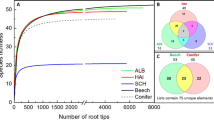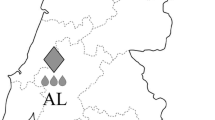Abstract
The species composition of ectomycorrhizal (ECM) fungal communities can be strongly influenced by abiotic and biotic factors, which determine interactions among the species such as resource partitioning, disturbance, competition, or relationships with other organisms. To verify whether ectomycorrhization of the root tips and composition of the ECM community in Norway spruce vary according to site features and if ECM species peculiar to these environmental variables can be detected, ten comparable stands differing in bedrock pH and exposure were selected and studied. The results demonstrated that tips vitality and ectomycorrhization degree do not change significantly either on the same tree, or among trees growing in the same stand, whereas they differ greatly with bedrock pH and exposure, even if no spatial or temporal trend were found. ECM species composition revealed instead a significant connection with the two environmental features, with a few species significantly associated to them. The results suggest that pH/exposure patterns play a primary role in the adaptive selection of ECM species constituting the consortium.


Similar content being viewed by others
References
Agerer R (ed) (1987–2002) Colour atlas of ectomycorrhizae. 1–12th delivery, Einhorn, Schwäbisch Gmünd
Agerer R (2001) Exploration types of ectomycorrhizae: a proposal to classify ectomycorrhizal mycelial systems according to their patterns of differentiation and putative ecological importance. Mycorrhiza 11:107–114
Agerer R (1991) Characterization of ectomycorrhizae. In: Norris JR, Read DJ, Varma AK (eds) Techniques for the study of mycorrhiza. UK Academic, London, pp 25–73
Agerer R, Rambold G (2004−2005) [update 2004-06-05] DEEMY—an information system for characterization and determination of ectomycorrhizae. http://www.deemy.de—München
Agerer R, Taylor AFS, Treu R (1998) Effects of acid irrigation and liming on the production of fruit bodies by ectomycorrhizal fungi. Plant Soil 199:83–89
Allen MF (ed) (1991) The ecology of mycorrhizae. Cambridge University Press, New York
Banfield JF, Barker WW, Welch SA, Taunton A (1999) Biological impact on mineral dissolution: application of the lichen model to understanding mineral weathering in the rhizosphere. Proc Natl Acad Sci USA 96:3404–3411
Beenken L, Agerer R (1996) Piceirhiza stagonopleres + Picea abies (L.) Karst. Descr Ectomycorrhizae 1:71–76
Berg B, Gronbach E (1988) Piceirhiza nigra. In: Agerer R (ed) Colour Atlas of Ectomycorrhizae. Einhorn-Verlag, Schwäbisch Gmünd, Pl. 19
Bernier N, Ponge JF (1994) Humus form dynamics during the sylvogenetic cycle in a mountain spruce forest. Soil Biol Biochem 26:183–220
Bruns TD (1995) Thoughts on the processes that maintain local species diversity of ectomycorrhizal fungi. Plant Soil 170:63–73
Cairney JWG, Chambers SM (eds) (1999) Ectomycorrhizal fungi: key genera in profile. Springer, Berlin
Conn C, Dighton J (2000) Litter quality influences on decomposition, ectomycorrhizal community structure and mycorrhizal root surface acid phosphatase activity. Soil Biol Biochem 32:489–496
Courty PE, Pouysegur R, Buee M, Garbaye J (2006) Laccase and phosphatase activities of the dominant ectomycorrhizal types in a lowland oak forest. Soil Biol Biochem 38:1219–1222
Courty PE, Pritsch K, Schloter M, Hartmann A, Garbaye J (2005) Activity profiling of ectomycorrhiza communities in two forest soils using multiple enzymatic tests. New Phytol 167:309–319
Dahlberg A (2001) Community ecology of ectomycorrhizal fungi: an advancing interdisciplinary field. New Phytol 150:555–562
Deacon JW, Fleming LV (1992) Interactions of ectomycorrhizal fungi. In: Allen MF (ed) Mycorrhizal functioning: an integrative plant-fungal process. Chapman and Hall, New York, pp 249–300
Del Favero R (ed) (2004) I boschi delle regioni alpine italiane. Tipologia, funzionamento, selvicoltura. Coop. Libraria Editrice, Padova
Dickie IA, Reich PB (2005) Ectomycorrhizal fungal communities at forest edges. J Ecol 93:244–255
Dickie IA, Xu B, Koide RT (2002) Vertical niche differentiation of ectomycorrhizal hyphae in soils as shown by T-RFLP analysis. New Phytol 156:527–535
Dighton J, Sjeffington RA (1987) Effects of artificial acid precipitation on the mycorrhizas of Scots pine seedlings. New Phytol 107:191–202
Erland S, Taylor AFS (2002) Diversity of ectomycorrhizal communities in relation to abiotic environment. In: van der Heijden M, Sanders I (eds) The ecology of mycorrhizas. Springer, Heidelberg, pp 163–200
Gehring CA, Theimer TC, Whitham TG, Keim P (1998) Ectomycorrhizal fungal community structure of pinyon pines growing in two environmental extremes. Ecology 79:1562–1572
Goodman DM, Trofymow JA (1998) Comparison of communities of ectomycorrhizal fungi in old-growth and mature stands of Douglas-fir at two sites on southern Vancouver Island. Can J Forest Res 28:574–581
Goodman DM, Durall DM, Trofymow JA, Berch SM (eds) (1996) A manual of concise descriptions of north american ectomycorrhizae: including microscopic and molecular characterization. Mycologue Publications and the Canada-BC Forest Resource Development Agreement, Pacific Forestry Centre, Victoria
Grayston SJ, Campbell CD (1996) Functional biodiversity of microbial communities in the rhizospheres of hybrid larch (Larix eurolepis) and Sitka spruce (Picea sitchensis). Tree Physiol 16:1031–1038
Harvey AE, Jurgensen MF, Larsen MJ, Graham RT (1987) Relationships among soil microsite, ectomycorrhizae and natural conifer regeneration of old-growth forests in western Montana. Can J Forest Res 17:58–62
Haug I, Pritsch K (eds) (1992) Ectomycorrhizal types of spruce [Picea abies (L.) Karst.] in the Black Forest. A microscopical atlas. Kernforschungszentrum Karlsruhe
Hill MO, Gauch HG Jr (1980) Detrended correspondence analysis, an improved ordination technique. Vegetatio 42:47–58
Horton TR, Bruns TD (2001) The molecular revolution in ectomycorrhizal ecology: peeking into the black-box. Mol Ecol 10:1855–1871
ISSS, ISRIC, FAO (eds) (1998) World Reference Base for Soil Resources. World Soil Resources. Reports 84. FAO Un, Rome
Izzo A, Agbowo J, Bruns TD (2005) Detection of plot-level changes in ectomycorrhizal communities across years in an old-growth mixed-conifer forest. New Phytol 166:619–630
Jabiol B, Brethes A, Ponge JF, Toutain F, Brun JJ (eds) (1995) L’humus sous toutes ses formes. ENGREF, Nancy
Jongman, RHG, ter Braak CJF, van Tongeren OFR (eds) (1995) Data analysis in community and landscape ecology. 2nd ed. Cambridge University Press, Cambridge
Kaldorf M, Renker C (2004) Characterization and spatial distribution of ectomycorrhizal aspen clones released in experimental field. Mycorrhiza 14:295–306
Kumpfer W, Heyser W (1986) Effects of stem flow of Beech (Fagus sylvatica L.). In: Gianinazzi-Pearson V, Gianinazzi S (eds) Physiological aspects and genetical aspects of mycorrhizae. Proceedings of the 1st European symposium on mycorrhizae. Dijon, 1–5 July 1985, INRA, pp 745–750
Landeweert R, Hoffland E, Finlay RD, Kuyper TW, van Breemen N (2001) Linking plants to rocks: ectomycorrhizal fungi mobilize nutrients from minerals. Trends Ecol Evol 16:248–254
Lilleskov EA, Bruns TD, Horton TR, Taylor DL, Grogan P (2004) Detection of forest stand-level spatial structure in ectomycorrhizal fungal communities. FEMS Microbiol Ecol 49:319–332
Lilleskov EA, Bruns TD (2001) Nitrogen and ectomycorrhizal fungal communities: what we know, what we need to know. New Phytol 149:154–158
Lilleskov EA, Fathey TJ, Lovett GM (2001) Ectomycorrhizal fungal aboveground community change over an atmospheric nitrogen deposition gradient. Ecol Appl 11:397–410
Lilleskov EA, Fahey TJ, Horton TR, Lovett GM (2002) Belowground ectomycorrhizal fungal community change over a nitrogen deposition gradient in Alaska. Ecology 83:319–332
Linderman RG (1988) Mycorrhizal interactions with the rhizosphere microflora. The mycorrhizosphere effects. Phytopathologia 78:366–371
Montecchio L, Causin R, Rossi S, Mutto Accordi S (2004) Changes in ectomycorrhizal diversity in a declining Quercus ilex coastal forest. Phytopathol Mediterr 43:26–34
Mc-Cune B, Grace JB (eds) (2002) Analysis of ecological communities. MjM Software Design, Gleneden Beach, Oregon
O’Dell TE, Ammirati JF, Schreiner EG (1999) Species richness and abundance of ectomycorrhizal basidiomycete sporocarps on a moisture gradient in the Tsuga heterophylla zone. Can J Bot 77:1699–1711
Perrin R, Estivalet D (1989) Mycorrhizal association and forest decline (yellowing of spruce). Agric Ecosyst Environ 28:381–387
Pfleger FL, Linderman RG (1994) Mycorrhizae and plant health. APS, St Paul, p 344
Provincia Autonoma di Trento (2001) I dati della pianificazione forestale aggiornati al 31/12/2000. Servizio Foreste-Sistema Informativo Ambiente e Territorio. CD-ROM, Trento
Read DJ, Perez-Moreno J (2003) Mycorrhizas and nutrient cycling in ecosystems—a journey towards relevance. New Phytol 157:475–492
Rosling A, Landeweert R, Lindahl BD, Larsson KH, Kuyuper TW, Taylor AFS (2003) Vertical distribution of ectomycorrhizal fungal taxa in a podzol soil profile. New Phytol 159:775–783
Rumberger MD, Münzenberger B, Bens O, Ehrig F, Lentzsch P, Hütt RF (2004) Changes in diversity and storage function of ectomycorrhiza and soil organoprofile dynamics after introduction of beech into Scots pine forests. Plant Soil 264:111–126
Sboarina C, Cescatti A (2004) Il clima del Trentino. Distribuzione spaziale delle principali variabili climatiche. Centro di Ecologia Alpina, report 33 and CD-ROM, Trento
Shi LB, Guttenberger M, Kottke I, Hampp R (2002) The effect of drought on mycorrhizas of beech (Fagus sylvatica L.): changes in community structure, and the content of carbohydrates and nitrogen storage bodies of the fungi. Mycorrhiza 12:303–311
Simard SW, Durall DM (2004) Mycorrhizal networks: a review of their extent, function, and importance. Can J Bot 82:1140–1165
Smith SE, Read DJ (eds) (1997) Mycorrhizal symbiosis, 2nd edn. Academic, London
Sterflinger K (2000) Fungi as geologic agents. Geomicrobiol J 17:97–124
Sverdrup H, Hagen-Thorn A, Holmquist J, Wallman P, Warfvinge P, Walse C, Alveteg M (2002) Biogeochemical processes and mechanisms. In: Sverdrup H, Stjernquist I (eds) Developing principles and models for sustainable forestry in Sweden. Kluwer, Dordrecht, pp 91–196
Taylor AFS (2002) Fungal diversity in ectomycorrhizal communities: sampling effort and species detection. Plant Soil 244:19–28
Taylor AFS, Alexander IJ (1989) Demography and population dynamics of ectomycorrhizae of Sitka spruce fertilized with N. Agric Ecosyst Environ 28:493–496
Taylor AFS, Martin F, Read DJ (2000) Fungal diversity in ectomycorrhizal communities of Norway sruce (Picea abies [L.] Karst.) and beech (Fagus sylvatica L.) along north-south transect in Europe. In: Schultze E-D (ed) Carbon and nitrogen cycling in European forest ecosystems. Ecological studies 142. Springer, Heidelberg, pp 343–365
Tedersoo L, Koljalg U, Hallenberg N, Larsson KH (2003) Fine scale distribution of ectomycorrhizal fungi and roots across substrate layers including coarse woody debris in a mixed forest. New Phytol 159:153–165
ter Braak CJF (1986) Canonical correspondence analysis: a new eigenvector technique for multivariate direct gradient analysis. Ecology 67:1167–1179
ter Braak CJF, Prentice C (1988) A theory of gradient analysis. Adv Ecol Res 18:271–317
ter Braak CJF, Šmilauer P (eds) (2002) CANOCO Reference manual and CanoDraw for Windows User’s guide: Software for Canonical Community Ordination (version 4.5). Microcomputer Power, Ithaca
ter Braak CJF, Verdonschot PFM (1995) Canonical correspondence analysis and related multivariate methods in aquatic ecology. Aquat Sci 57:255–289
Toljander JF, Eberhardt U, Toljander YK, Paul LR, Taylor AFS (2006) Species composition of an ectomycorrhizal fungal community along a local nutrient gradient in a boreal forest. New Phytol 170:873–884
Waller K, Brand F, Agerer R, Taylor A (1993) Piceirhiza oleiferans. In: Agerer R (ed) Colour atlas of ectomycorrhizae. Einhorn-Verlag, Schwäbisch Gmünd, Pl. 79
Weiss M (1988) Ektomykorrhizen von Picea abies. Synthese, Ontogenie und Reaktion auf Umweltschadstoffe. Dissertation, University München, Munchen
Acknowledgments
The Ph.D. scholarship of the first author and her research were supported by the Centro di Ecologia Alpina (TN), through the “Fondo per i progetti di ricerca della Provincia autonoma di Trento”, “DINAMUS Project”, 437/2002.
Author information
Authors and Affiliations
Corresponding author
Additional information
Communicated by R. Hampp.
Rights and permissions
About this article
Cite this article
Scattolin, L., Montecchio, L. & Agerer, R. The ectomycorrhizal community structure in high mountain Norway spruce stands. Trees 22, 13–22 (2008). https://doi.org/10.1007/s00468-007-0164-9
Received:
Revised:
Accepted:
Published:
Issue Date:
DOI: https://doi.org/10.1007/s00468-007-0164-9




